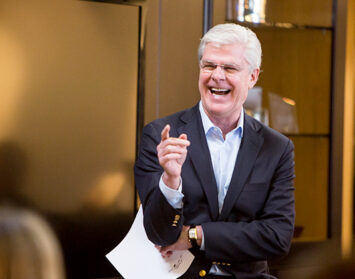By Gary Shaw and Timothy J. McClain
When it comes to brokering office space deals Downtown, nobody does more of it than Jason Hughes.
Sipping a Louie & Mousie’s cappuccino milk shake, 30-year-old Jason Hughes discusses life as the leading player in San Diego’s classiest office real estate market: Downtown.
Not only in the last 18 months has Hughes leased nearly 400,000 square feet of office space, or enough to fill Emerald Plaza and then some, in about that same time he’s also pulled off a Downtown first: brokering the sale of three office towers and consulting to the buyer of a fourth. For good measure, in the past year he earned his master’s of business administration degree from the University of San Diego.
Life is good for this hard working, straight shooting, clean living (no booze or smokes) young man who lives with his college sweetheart and three children on a two-acre pad in Del Mar just outside of the Rancho Santa Fe covenant.
Yet he worries, driven by fear that someone might come along and make better deals for tenants. It keeps him up at night, interrupting his ability to relax, sort of like how the Goodwill trucks running down Fifth Avenue distract him during this interview, first from the noise as they rumble by and seconds later when they set off the alarm in his late-model BMW, forcing him to jump up and shoot things quiet with his key-chain clicker. “It’s never been this sensitive before,” he apologizes.
Patient and polite — though he’s known to be less so with adversaries — Hughes is proud of his accomplishments yet worries that in recounting them he will come across as a braggart. Still, he answers almost every question, hedging only on certain personnel matters and the firm’s revenues.
Among his biggest fans is Craig Irving, Hughes’ partner and the man who’s now No. 2 in recent Downtown leasing volume. (Irving recoils at the thought of intra-office competition and says he could live with being dead last as long as the firm thrives.)
“I think that his desire for achievement is a very high-quality attribute,” Irving says. “When Jason represents a client, he works 100 percent on that client’s behalf. A lot of people get a client and then the hard work is over and it is kind of put on cruise control. If you are being represented by Jason, you are very fortunate.”
Many clients and landlords alike are Hughes fans.
David Russell, vice president of Compass Management and Leasing Inc., has worked with Hughes on leases for nearly 40 tenants in Wells Fargo Plaza and the First National Bank Center. “Jason just has the ability to get in quickly, understand clients’ requirements and make those matches and appropriate recommendations in a timely fashion. Most tenants don’t want to make a project out of moving. They want that to be a process which they go through quickly and then are back doing whatever it is they do.”
“He has a fantastic demeanor and a great negotiating style,” says Douglas Hageman, the general counsel for TrizecHahn, the West Coast’s largest regional shopping center owner, developer and manager. The company’s properties include Horton Plaza, North County Fair, Parkway Plaza and UTC, the latter which provides the view from TrizecHahn’s offices in the Regents Square II Tower. When its lease was up, Hughes helped TrizecHahn develop an option for Downtown space overlooking Horton Plaza that gave more leverage in its landlord negotiations. TrizecHahn eventually stayed in the same building, leasing 90,000 square feet on five floors last year in what was the Golden Triangle’s largest lease ever and San Diego’s largest Class A office lease of the year. “He is very, very bright,” Hageman says of Hughes. “We were very happy with him.”
Gray Cary Ware & Freidenrich, San Diego’s largest law firm, has Hughes on retainer. “Jason is our broker of choice,” says Terry O’Malley, managing partner. “We are very sophisticated users of professional services and Jason is an excellent example of someone who provides a real value-added service. He has an unparalleled knowledge of the leasing market, and has at his fingertips all the leasing information you could want on space that is available and (space that) is currently occupied but may be available in the future.”
And then there’s Hughes’ first client, attorney Howard Wiggins. “We have worked with Jason for a long time, but I didn’t realize that we were his first,” Wiggins says laughing. “Jason has been very helpful. We have enjoyed his personal charm and his ability to get the work done.”
A San Franciso-area native, Jason Hughes was born in San Rafael on March 31, 1967. His parents moved the family to Portola before settling in San Mateo in his third-grade year. The oldest boy and second oldest of six children, Hughes grew up in pricey neighborhoods. His father, who owned a direct mail printing company, was big on having the best real estate the family could afford. With six kids, disposable income was scarce.
“My parents always lived in a nice neighborhood, but I was always the poorest in the neighborhood,” Hughes recalls. “I never had any money. So I was always competing against my friends who would have unlimited amounts of money. For example, ski season would come around. They would all be members of the mogul ski club. They would go up skiing every weekend.” Holding a steady job allowed him to join his buddies on the slope once a month.
The ability to earn money was something Hughes learned early in life. On his seventh birthday he bought a bicycle using $100 he earned doing yard work. As a young teen he took up caddying at local golf courses. At 15 he got a job at the local Longs Drug Store, starting at 20 hours a week and ending up at nearly twice that during his senior year of high school. The effort paid rewards, such as allowing him to buy, months before his 16th birthday, a new BMW 2002.
It was a job-shadowing experience during a high school Junior Achievement class that introduced Hughes to the real estate business. He was paired that day with a senior broker from Cushman & Wakefield. “I did this day-long deal where I would go out and he would do his business and I would be his sidekick. I remember I got in his car and he had one of the nicest, newest and largest Mercedes. At that point I knew that this is what I wanted to do. I loved buildings. I loved anything to do with commercial real estate. I am talking high-rises especially.”
Hughes’ penchant for work depressed his high school grades and limited his college options. Ultimately, he selected Principia, a 900-student Christian Scientist school in Illinois. Two weeks before classes started, he was in Boston at an underage nightclub where he met Shay Holder, who would later become his wife. “We looked across the room and it was like fate,” Hughes says of the East Coast encounter between two California natives, both bound for the same small college.
Principia, however, was too small and within a year, in 1987, he and his wife had transferred to Pepperdine, with Hughes’ 4.0 grade average earning him a 50 percent scholarship. Pursuing a business degree with an emphasis on real estate, Hughes continued to work. “I had my real estate license and I sold either two or three houses,” he says. “I was also working at the Chart House as a cook in Malibu and Westwood to get the hours.”
To boost his practical experience, Hughes interned his senior year at Cushman & Wakefield in Century City. When he graduated in the summer of 1989, the company offered him a job working for brokers who specialized in Century City, Westwood and Santa Monica. Both he and Shay, who was then working for Barry Diller at Fox, decided to leave Los Angeles. “We both said this is not where we want to raise a family and be long term,” Hughes recalls. “In this business you’ve got to look extremely long term, because it’s all relationships. You can’t just pack up and say, ‘Because I’m successful here I’ll be successful there.”
The day the pair graduated, they packed up Hughes’ Datsun B210 — the BMW was sold to help pay for college — and moved to San Diego and into her parents’ home. “They had a guest house and I stayed at it because we weren’t married yet.” (They exchanged vows on Oct. 7 behind Seaport Village with Downtown’s high-rises providing the backdrop.) Of course, Hughes had a job his second day in San Diego.
“The last two months of school I was coming down here regularly interviewing with Grubb &
Ellis and Burnham,” he says. “I had done my research. All I saw were Grubb & Ellis signs so I thought that was definitely the better company to be with in Downtown, which was really my interest. But I went through and interviewed at both Grubb & Ellis and Burnham and was ultimately offered employment at both.”
Neither, however, wanted to turn him loose on Downtown’s office market. Grubb & Ellis had a retail “runner” position in mind, while Burnham wanted him in Kearny Mesa. “I was not excited about either one,” he says.
The Burnham position seemed best, and Hughes got as far as then-President Bob Lichter’s office taking a psychological test when he gave one last call to Jim Stendrup, the regional manager at Grubb & Ellis. “I called Jim and said, ‘I’m in Bob Lichter’s office and have been offered this job. Isn’t there something else you might have for me?’ He said, ‘Jason, leave right now. You’ve got yourself a job. Get over here and I’ll tell you what you’ll be doing and we’ll have you Downtown.— He left without finishing the test.
Hughes’ position was unique. Instead of serving as an entry-level runner for a territory, he was assigned to assist more senior brokers in leasing Symphony Towers, then the biggest, newest and, parking garage aside, nicest high-rise in San Diego. “What an incredible project,” he says.
Reporting to Stan Perry, Hughes loved the work. But money quickly became an issue. Feeling sick all the time, Shay had quit her job at Blue Book Publishing in La Jolla, figuring it was stress. Hughes, as a runner, was earning $1,000 a month at Symphony, with no chances at a bonus. The rent on the couple’s small but fashionable UTC apartment was $825 a month, exceeding his take-home pay. Then they learned Shay was pregnant.
“I’m sitting here making $800 a month, saying, ‘What the heck are we going to do?”‘ he says. “So my in-laws fired their gardener, who they were paying $125 a week, and I became the gardener. Every weekend I had no life. All day Saturday I would be in the office and on Sunday they had an acre or an acre and a half — I would mow the lawn with this hand mower. I remember it took me hours and hours to do that. I remember her mother bringing us over a box of food. That’s how we made ends meet.”
Hughes earned himself a small promotion and in calendar 1990 recalls earning about $18,000. “In this business, because of all the other costs and as an independent contractor, that’s not much,” he says. “You’re paying for everything yourself. That really chews at your disposable income. With a wife not working and a daughter born in August, it was really, really tough.”
But not insurmountable.
A serious believer in positive thinking, lots of marketing and motivational books — he’s essentially memorized Earl Nightingale’s “The Strangest Secret” and listens to the book on tape in his car — Hughes set out to get the name “Jason Hughes” established with office tower tenants.
Recounting his marketing strategy during a drive through Downtown, Hughes pulls over and parks on Fourth Avenue, just below Cafe 222. Opening up a marketing and news clip scrapbook he’s brought along, he points out a favorite: gray “quote cards” he had printed each month for about a year and a half. Written in blue on the outside is a famous saying he selected. On the inside is a handwritten note about something relevant to the month or his life — in one case he sent a photo of himself, Shay and their new baby. On the card’s back was his name and address at Grubb & Ellis, but nowhere would it say “Grubb & Ellis.” He and Shay then would hand-address envelopes and mail nearly 1,500 of the cards to tenants Hughes had cataloged during his regular building scouting trips.
“I look back and say, ‘How corny is this? How dumb?”‘ Hughes laughs. “But you know, people don’t remember (the corny part). It’s just trying to differentiate yourself.”
Once at Symphony Towers he pushed his marketing mania too far.
The tower was inviting local heavyweights to concerts in the newly renovated Symphony Hall. Hughes was getting a hold of the RSVP lists. “(The lists) would just be a who’s who of San Diego,” he says. “I would send them all personal notes, saying ‘I’m really glad you’re coming. I’m looking forward to meeting you.’ So several people called the building and said, ‘Who the hell is this Jason Hughes guy? And I’m not interested in meeting him.’ The building (management) got mad at me and said, ‘What are you doing?’ I was just sitting there trying to do something different. 1 was always doing weird stuff like that.”
About two years after joining Grubb & Ellis, Hughes moved over to Goldman Ferguson Partners. At Goldman, Hughes refined his marketing approach, pushing the company to aggressively advertise in local business media. He brought that penchant to his pairing with Craig Irving at The Irving Hughes Group, where aggressive advertising is now common in the San Diego Metropolitan and infrequent in the Daily Transcript and Business Journal.
What attracted Hughes to Goldman was its focus on tenant representation as opposed to representing landlords and tenants, or, in some cases, both parties. Also, he no longer had to split commissions, as was required at Symphony Towers, or put in hours of work on a proposal only to see the tenant go elsewhere. Hughes also learned the leverage game.
“If I’m representing all of these tenants, landlords are going to start treating me real nice,” he says. “They realize I don’t have just this 2,500 square-foot tenant I’m trying to negotiate a lease for. I’ve got 50,000-plus square feet of tenants in my files that I’m working with. If they jerk me around on this one, they might not see the others.”
As Hughes built his client list, he found himself dueling with the then-king of Downtown leasing: Craig Irving. At the time Irving and partner John Donovan, both of whom had much earlier left John Burnham & Co., were the top dogs. “Craig was by far my biggest competitor,” Hughes says. “If I didn’t get it, he did, and vice versa.”
Irving has the same memories. “Jason was really a thorn in our side for a couple of years,” Irving recalls. “His name kept coming up in our marketing meetings as someone representing a tenant and we kept asking ourselves, ‘Who is this guy?”
In 1993, Donovan decided to pack it in, leaving Irving to ponder his future. Hughes sensed a great collaboration and pursued Irving with his typical aggressiveness. Ultimately, he joined what was then The Irving Group as an employee. Although his eventual ascendency to partnership status was planned, the arrangement left Irving with the power to end the relationship should conflicts arise. They didn’t. Instead, working together the two consolidated their grip on Downtown and, since 1993, have handled close to 65 percent of the leases involving a tenant represented by a broker. In January 1995 the name was changed to The Irving Hughes Group Inc. and the two became 50-50 partners.
Since Hughes came on board, the company also has expanded dramatically. From those days of one secretary and the two partners, The Irving Hughes Group two months ago added its 11th employee, Ramona Holmes, as office manager, and will grow by three more employees this month. Its brokerage staff is a roster of top performers in various categories and geographic areas of the county, all wooed to the firm. Neither partner would divulge revenues, although both are expected to earn seven-figure incomes this year.
Financial and marketplace success aside, Hughes, the consummate planner, remains restless. “I am never content,” he says. “I am always looking for how we can improve the service. How do we create more value for our clients? How do we grow the company? How do we get more clout in the marketplace? More leverage? Who cares about yesterday; what can we be going toward?” To clear his head he vacations solo on Maui a couple of times a year where he windsurfs and works on private one-, five- and 10-year plans. For a quicker stress reliever, he’ll drive to Mt. Whitney to hike up and back in a single day.
Hughes sees the beauty of the leasing industry as its endurance. “Even in the worst of times, if tenants are going to contract, they need to renew their lease,” he says. “Very few law firms are going to say, ‘We are moving out all together and we are all going to work out of our houses.’ They are all going to do something. —
Positive thinking aside, Hughes has taken his lumps. When he was with Goldman Ferguson, he signed a contract, later amended, with Bruce Stark to help the developer find a buyer for his troubled One Harbor Drive condominium project. Hughes says he introduced Stark to the eventual buyer, the Leucadia National Corp., and was due a $540,000 commission. On a 9-3 vote, after a year-long trial, a jury disagreed.
The experience does not cause Hughes to shy away from brokering big sales. Indeed, his relentless digging made him one of the first San Diegans to learn that Arizona-based Southwest Value Partners was considering buying Emerald Shapery Center. With sketchy information, he used directory assistance to track the company down in Scottsdale, then bluffed a receptionist into believing he knew about the deal and needed to talk with the person in charge. She directed him to Mark Schlossberg.
“I called Mark and said, ‘Mark, look, I know you are trying to purchase Emerald-Shapery Center, but you need my help,”‘ Hughes says.
Schlossberg chuckles when he recalls the conversation. “I was just surprised he knew,” he says. “When he told me he had found out and started asking me about it, I couldn’t talk to him. But I came to realize that Jason makes it a point to know absolutely everything that is going on downtown. And he really does.”
That call led to a consultant’s contract for advice on how to lease the now-Emerald Plaza, and then the opportunity to serve as a broker when Southwest moved aggressively in the Downtown market. With Hughes acting as the broker, the company bought 600 B Street, now the Comerica Bank Building, for $5 million. (It was Craig Irving’s work that allowed Southwest to pay the city of San Diego 5400,000 for an option on the building that moved Southwest ahead of an earlier would-be buyer.) Then Southwest, represented by Hughes, bought 525 B Street for $19 million and First National Bank Center for $67 million.
The relationship introduced Hughes to Robert Sarver, the controlling principal of Southwest Value Partners and the chairman of GB Bancorporation, the parent of Grossmont Bank. Hughes is greatly impressed with Sarver and views him as a role model.
“What I like so much about him is he thinks outside the box,” Hughes says. “He thinks big. I like the motto, “Think big. Be big.’ He is able to do things most people never dream of just because he decides to do it.”
Hughes has slowed a bit lately, usually making it home by 7:30 each night instead of the 10-11 p.m. that was the norm. And in his spare time, he can be found hanging out with his children, or maybe puttering around the backyard or house where two dogs — a golden retriever and Labrador — join a cat as family pets.
His plans for the future remain secret for now, although you can be sure they are written down on a legal pad. “I’m going to be around here for a long time,” he says. “Maybe not in a broker’s capacity, but San Diego is where I’m going to be.”
A Priceless Cover Charge—The extra $50,000 would be nice but then the editor would demand his share. While he retains veto power, The Irving Hughes Group principal Craig Irving gives his partner Jason Hughes wide latitude in developing the firm’s marketing campaign. In a series of advertisements published in this magazine, some of which also have been published elsewhere, the commercial real estate brokerage mostly touts its own accomplishments, although it occasionally has incurred the wrath of competitors by knocking them, not individually, but as a group.
One ad criticizes many commercial real estate brokers as “little more than… glorified tour guides.
“In fact,” the ad continues, “most ‘brokers’ aren’t even brokers — they’re licensed salespeople… Even worse, most have a conflict of interest by representing landlords as their primary business.”
A frequent theme of The Irving Hughes Group’s ads is its moral high ground, exclusively representing tenants in lease negotiations, unlike other firms that may represent the landlord and tenant in the same transaction. The target audience for these ads are commercial tenants, of course.
Kraig Kristofferson, a popular veteran broker with CB Commercial Real Estate Group Inc. (and handsomer brother of the actor), complained of the ad last February to Bob Harp, president of the San Diego County Commercial Association of Realtors. Hughes’ partner, Irving, was president-elect of the association at the time.
“It is one thing for a company to tout its capabilities and successes,” Kristofferson complains in a Feb. 14 letter to Harp, “but quite another thing to denigrate the competition. To imply the rest of us have questionable ethics and education, and to refer to us as ‘glorified tour guides’ is certainly unfair and a negative depiction of our industry.”
Not all of The Irving Hughes Group’s competitors were so irritated, though. “They’re just saying it the way it is,” Bill Munster, a broker with John Burnham & Co., laughs after reviewing the controversial ad.
Nonetheless, Irving pulled the ad, which had first run in October 1996.
The Irving Hughes Group’s holier-than-thou attitude toward competitors especially irritates those who point to Hughes’ representation of Downtown San Diego’s largest private landlord, Robert Sarver and his Southwest Value Partners affiliates, in their acquisition of four Downtown office towers. Matt Spathas, an executive of Sentre Partners, is said to be unforgiving toward Hughes for having engineered the sale of 600 B Street out from beneath Sentre Partners, which had an earlier near-buyer in place.
The Irving Hughes Group “absolutely does not” have a conflict of interest when bringing client tenants to the table with Southwest Value Partners, says Hughes.
“First of all, even from the California Department of Real Estate point of view, a conflict means you have to be directly representing two parties in the same transaction. So the actual conflict is nonexistent. We do not ever represent Southwest in their lease transactions; tenants only.
“In dealing with a perceived conflict, if our competitors want to hammer it, they can say whatever they want. The reality is, we do many times their number of transactions in Downtown. Southwest has four buildings. We do a lot of transactions with them, as we do with every building owner.”
The Irving Hughes Group also represents tenants looking to become owners by buying their own space.
Part of our jobs as journalists is to anticipate the questions of readers, and in that vein, we’ve presumed readers in the commercial real estate business might wonder if The Irving Hughes Group “bought” the cover story this month. It didn’t. And shame on you for wondering. Covers aren’t for sale; neither is any of the editorial in this book. This is our 12th monthly edition since this publisher bought the magazine, and this is the first instance in which an advertiser became a cover story, although some intelligent cover- story subjects subsequently became advertisers. Cover subjects are chosen usually for their extraordinary stories, and Irving, at age 35, and more so Hughes, at 30, are certainly newsworthy for their extraordinary accomplishments so early in their careers. They’ve probably put more good tenants in more good office space in Downtown than anyone else in the last two years, and they do good work in Carlsbad, North City and Mission Valley, too.
We’re also happy to acknowledge that some very smart The Irving Hughes Group competitors also are advertisers, including CB Commercial Real Estate Group, Inc., John Burnham & Co./Oncor, Southwest Value Partners and Trilogy Real Estate Management Inc., among others, and we think all of them are wise for using the least expensive and highest quality medium to reach the largest business audience in San Diego. Together, these real estate advertisers represent most of the commercial property transactions in San Diego County in the last 24 months.
Jason Hughes is chairman, CEO, and owner of Hughes Marino, an award-winning commercial real estate company with offices across the nation. A pioneer in the field of tenant representation, Jason has exclusively represented tenants and buyers for more than 30 years. Contact Jason at 1-844-662-6635 or jason@hughesmarino.com to learn more.







